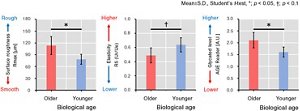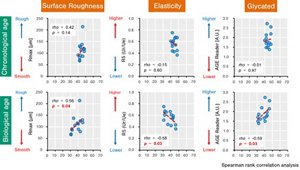Skin Surface Lipids–RNA Monitoring Technology:
Assessment of Variations in Individual Skin Aging:
By Estimation of "Biological Age," Based on Skin Surface Lipids-RNA
The Biological Science Research Laboratory of Kao Corporation (President: Yoshihiro Hasebe) has found that the degree of skin aging, which varies among individuals, may be assessed by estimating the "biological age" of the skin. This can be done by utilizing expression information of ribonucleic acid (RNA) in skin surface lipids (SSL-RNA), which changes with aging, in combination with machine learning.
These findings were reported at the 21st Scientific Meeting of the Japanese Society of Anti-Aging Medicine, held in Kyoto (on site) and online from June 25 to 27, 2021, as well as the 86th Society of Cosmetic Chemists of Japan (SCCJ) Research Symposium, held online on July 15, 2021. At the SCCJ symposium, the presentation of these findings won the best presentation award.
Background
Aging is a phenomenon that closely related to decline in various physical functions over time. The degree and symptoms of aging vary even among individuals of the same chronological age. Recently, the concept of biological age, which indicates the degree of aging and is estimated from the degree of decline in physical functions, has drawn the attention of researchers.
The SSL-RNA monitoring technology reported by Kao in 2019 enables the collection and analysis of SSL-RNA from facial sebum without damaging the skin.*1 Information on biomolecules which change with age, such as RNAs and proteins, plays an important role in estimating biological age. In the study detailed below, Kao investigated whether the biological age of the skin can be estimated using SSL-RNA expression information.
-
* 1 Kao news release on June 10, 2019, entitled "Kao's original non-invasive analytical method for monitoring RNA - Discovery of the presence of human RNA in sebum"
https://www.kao.com/global/en/news/rd/2019/20190610-002/
Estimation of biological age utilizing SSL-RNA
In a previous study, Kao demonstrated that SSL-RNA expression patterns change with age.*2 In the study described below, Kao conducted enrichment analysis*3 of 368 RNAs that are significantly associated with chronological age in 113 women aged 20 to 59 years. The analysis revealed that SSL-RNAs, whose expression patterns change with aging, contain various components that are responsible for aging-related functions including inflammation, cell death, cellular senescence, epidermal differentiation and so on. Based on these results, Kao considered that the use of SSL-RNA could enable us to estimate the degree of aging of the human body.
To demonstrate this, Kao constructed and evaluated a machine learning model that predicts age based on the expression levels of 368 RNAs that change with aging using the same study subjects as those in the analysis mentioned above.*4 This evaluation showed a high correlation between the predicted and actual chronological ages (Figure 1). However, even among the same age group, some subjects showed higher or lower predicted age than others. Therefore, the predicted ages suggested biological ages, reflecting the degree of variation in aging among individuals.
-
* 2 Kao news release on November 16, 2020, entitled "Skin Surface Lipids–RNA Monitoring Technology: Highly Precise Predictions of Constantly Changing Skin Conditions with Skin Surface Lipids-RNA Monitoring Technology"
https://www.kao.com/global/en/news/rd/2020/20201116-001/ -
* 3 A method to analyze whether genes that are responsible for particular functions in common are enriched in multiple genes of interest.
-
* 4 The subjects were partitioned to one of two groups: either to train a machine learning model (n=58) or to test the model (n=55).

Figure 1. Correlation between the chronological ages and the ages predicted with the machine learning model
Verification of the validity of biological age estimated from SSL-RNA expression information as an index of skin aging
In this study, ages predicted by the machine learning model were defined as biological ages and were verified to determine whether they were valid as an index of skin aging. In a group of participants in their 40s (n=14), among whom skin aging was expected to vary considerably by individual, participants in the upper 25% of biological age (older biological age group) and those in the lower 25% of biological age (younger biological age group) were included in the analysis to compare skin measurements between the groups. In the analysis, the older biological age group (n=4) showed more skin roughness at the outer corner of the eyes (larger number of and/or deeper wrinkles), less skin elasticity around the eyes, and more glycated level of the skin around the mouth compared with the younger biological age group (Figure 2).
Based on these findings, it was considered that biological age estimated from SSL-RNA is a valid index of skin aging because individuals whose biological age was relatively older tended to show more aged skin.

Figure 2. Comparisons of skin measurements in individuals in their 40s (chronological age)
Furthermore, the correlations between skin measurements related to skin aging and biological age or chronological age were analyzed in the same age group to verify to what extent biological age can reflect skin aging compared with chronological age. As a result, it was revealed that biological age significantly correlates with skin measurements while there were no significant correlations between chronological age and skin measurements in the group in their 40s (Figure 3). These findings indicate the possibility that biological age estimated from SSL-RNA by using machine learning more strongly reflected the degree of skin aging.

Figure 3. Correlations between skin measurements and chronological age / biological age
Conclusion
It is known that human skin conditions are significantly affected by aging as well as individual environmental exposures such as ultraviolet rays and diet. The study described above demonstrates that biological age information reflecting the degree of skin aging may be obtained from SSL-RNA. Although chronological age is irreversible, there is a possibility that biological age can be changed for the better by improving environmental factors.
Kao will further accumulate SSL-RNA data to improve the performance of biological age estimation with the goal of applying it to understand the variations in individual aging and to develop optimal approaches to body and skin care.
About Kao
Kao creates high-value-added products that enrich the lives of consumers around the world. Through its portfolio of over 20 leading brands such as Attack, Bioré, Goldwell, Jergens, John Frieda, Kanebo, Laurier, Merries, and Molton Brown, Kao is part of the everyday lives of people in Asia, Oceania, North America, and Europe. Combined with its chemical division, which contributes to a wide range of industries, Kao generates about 1,400 billion yen in annual sales. Kao employs about 33,000 people worldwide and has 130 years of history in innovation. Please visit the Kao Group website for updated information.
Media inquiries should be directed to:
Corporate Strategy
Kao Corporation
